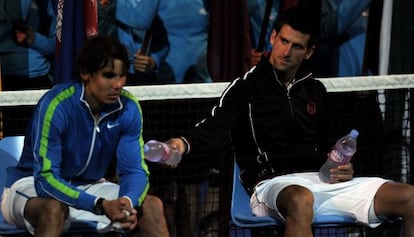Nadal's fortress faces Djokovic test
Spaniard is defending more points than any other player on the European circuit

Montecarlo, alongside Roland Garros, is one of the jewels of the European clay-court circuit. It was in the principality, in 2003, that Rafael Nadal became known to the world after he beat then-world number seven Albert Costa in round two. It was there, in 2010, that the Majorcan wept like a child after winning the title to break a drought of almost a year without lifting a trophy.
In 2011, the world number two won his only Masters 1000-level tournament of a season during which he lost four finals of the same tier against Novak Djokovic. And it is in Montecarlo that the world number one will begin his assault on Nadal's clay-court throne. The Serb did not play in 2011, when Nadal won a tournament he dearly loves for a record seventh consecutive year; Montecarlo is where the Spaniard gets his feel for the clay and gauges his sensations for the European season on the surface.
"Montecarlo, for Rafael, is a special tournament," confirms the number two's uncle and coach, Toni Nadal, who watched as his nephew retired from the recent Miami Masters at the semifinal stage with renewed tendinitis problems in his knees.
"It's obvious he hasn't had a lot of time to prepare. He's always got good results here; he's played good matches and this is a tournament he enjoys, as though he were at home. He's playing well at the moment. In Miami, he had to serve shorter because the problem in his knees meant he couldn't push off well. But clay is one thing and hard courts are quite another. Just as he made adjustments to be more aggressive on hard courts, on clay he will mix it up a bit but without doing anything crazy. He's always done pretty well here!"
But despite Djokovic's dazzling 2011 season, no player has more points to defend between Montecarlo and the grass of Queen's Club than Nadal. Even though he lost in the finals at Rome and Madrid, to later win Roland Garros, Nadal has 4,200 points to defend - the thick end of his ranking - to Djokovic's 2,970, Roger Federer's 1,830 and Andy Murray's 1,530. The Spaniard's first match of the European season will be against Jarkko Nieminen on Wednesday.
Nadal's number-two ranking, which means he avoids Djokovic until the final of tournaments, is at stake.
As soon as he got back from Miami, the Spaniard set out to resolve the tendinitis problem in his left knee. He embarked, as he does periodically, on a painful plasma treatment. The technique "manages to imitate and accelerate [by almost 40 percent] the physiological mechanisms of recovery that spontaneously begin in tissue after an injury," according to the Spanish company that develops it. "What is achieved is the substitution of the damaged tissue with new tissue, in a natural process, but in considerably less time than with conventional treatments." Nadal did not go back into training until two days before he traveled to Montecarlo.
The Spaniard, who hopes that the more forgiving clay will protect his joints and temper the pain in his knees in comparison to the abrasion of cement, will need all this and more to defend his fiefdom. Montecarlo is a blessing for his style of play; it is on clay, at sea level, and the club awakens his sentimental side because it is small and cozy.
For seven consecutive years, Nadal has repeated the ritual of lifting the Montecarlo trophy. He has lost just once, in 2003 to eventual runner-up Guillermo Coria, and holds a 39-1 record. But this year he is playing for more than the title. His future belief, the self-confidence he will need in tournaments to come, the faith that he can defeat Djokovic, who has beaten him on the last seven occasions they have met... all this will be in play on the Montecarlo clay.
Tu suscripción se está usando en otro dispositivo
¿Quieres añadir otro usuario a tu suscripción?
Si continúas leyendo en este dispositivo, no se podrá leer en el otro.
FlechaTu suscripción se está usando en otro dispositivo y solo puedes acceder a EL PAÍS desde un dispositivo a la vez.
Si quieres compartir tu cuenta, cambia tu suscripción a la modalidad Premium, así podrás añadir otro usuario. Cada uno accederá con su propia cuenta de email, lo que os permitirá personalizar vuestra experiencia en EL PAÍS.
¿Tienes una suscripción de empresa? Accede aquí para contratar más cuentas.
En el caso de no saber quién está usando tu cuenta, te recomendamos cambiar tu contraseña aquí.
Si decides continuar compartiendo tu cuenta, este mensaje se mostrará en tu dispositivo y en el de la otra persona que está usando tu cuenta de forma indefinida, afectando a tu experiencia de lectura. Puedes consultar aquí los términos y condiciones de la suscripción digital.
Últimas noticias
From digital curfews to blocking apps: How technology experts protect their children online
Why the price of coffee has skyrocketed: from Brazilian plantations to specialty coffee houses
Confined to a Cuban hospital: When electricity is a matter of life or death
The complicated life of Francesca Albanese: A rising figure in Italy but barred from every bank by Trump’s sanctions
Most viewed
- Why we lost the habit of sleeping in two segments and how that changed our sense of time
- Trump’s obsession with putting his name on everything is unprecedented in the United States
- Pablo Escobar’s hippos: A serious environmental problem, 40 years on
- The Florida Keys tourist paradise is besieged by immigration agents: ‘We’ve never seen anything like this’
- Charles Dubouloz, mountaineering star, retires at 36 with a farewell tour inspired by Walter Bonatti









































